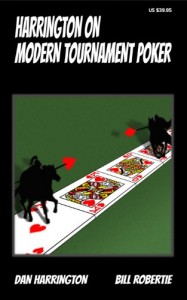This year, marks the 10th anniversary of Harrington on Hold ‘Em Volume I which was a landmark poker strategy book by Dan Harrington and Bill Robertie. Their work revolutionized the way many players thought about the game and changed tournament poker forever. As a result of that book, we see much better players in today’s tournaments on average than was common 10 years ago. More of today’s players understand that winning poker is aggressive poker.
The authors recently released an updated version of their book to once again teach the masses how to improve their play and to explain how poker has changed in the modern era. Unfortunately, they did such a good job 10 years ago that they could not find much to add towards this first goal and they did not include enough material to really capture the latter one.
The first part of this book covers the basics of No Limit Hold ‘Em tournaments. This seems like a good place to start, but if you’ve already read the original Harrington book then you know most of this material already. Like Volume I, this section is great for beginning players, but it only devotes a few pages to what most of us would call “modern tournament poker.” It gives a short explanation of smaller preflop bets, light 3 and 4 betting, smaller c-bets, and the general concept of small ball poker, but it only spends a total of 12 pages on these concepts. By my calculations, only about 15% of Part I covers these major areas of modern tournament poker and only superficially at that.
 The second part is more of the same, although it does a bit better by spending more time on the concepts of ICM and range based play. However, it’s section on “Evaluating Tournament Formats” does not cover truly modern options like big bounty tournaments, re-entry tournaments, ante only tournaments, etc. When I think modern tournament poker, I think online poker. In my opinion, this would have been a good place in the book for online specific concepts such as using the various software tools. Even if the intent was to focus more on live poker, there could have been a section on selling action and deal making which have certainly become a feature of modern tournament poker over the last ten years.
The second part is more of the same, although it does a bit better by spending more time on the concepts of ICM and range based play. However, it’s section on “Evaluating Tournament Formats” does not cover truly modern options like big bounty tournaments, re-entry tournaments, ante only tournaments, etc. When I think modern tournament poker, I think online poker. In my opinion, this would have been a good place in the book for online specific concepts such as using the various software tools. Even if the intent was to focus more on live poker, there could have been a section on selling action and deal making which have certainly become a feature of modern tournament poker over the last ten years.
The next four parts of the book are dedicated to each of the four betting rounds. Again, there is not much new here. I think a better job could have been done as it relates to one play in particular. I credit Volume I with teaching me about the squeeze play in poker. Once everyone learned to do that, some players in the modern poker era adapted by flatting with some strong hands when they knew they had a habitual squeezer behind them. Neither the squeeze play nor this response to it were mentioned in the preflop section. This rehashing of old ideas while saying very little about new ones continues until the last part of the book.
The eighth and final part of the book is on Playing Styles. It includes sections on how to play the “Modern Loose-Aggressive” style and how to counter it. The review of the basics from the previous parts, coupled with the material in this last one, may be worth the price of the book if your game has been at a standstill over the past few years. Many very successful poker players play the LAG style in the modern poker era. If you can understand when and how to play this style yourself, as well as how to adjust when others are playing this way, you will make huge improvements in your game. This is easily the best section of the book, but I would argue that even this has been better covered by other modern era poker books. Unless you never got the chance to read Volume I by Harrington and Robertie, I cannot suggest you buy this book. It is great for general tournament basics, but modern tournament poker is better covered by other options on the shelves.



colonelu
Hey Carlos,
Can you please suggest some mtt books where you consider the LAG style is better covered?
Thanks!
Carlos
Yes. Playing The Player by Ed Miller. It tells you exactly how to beat LAG players. Excellent book.
colonelu
Thanks Carlos for the answer!
Yes, indeed, Playing the Player is a very good book, I have read it, and I think I will do it again! But I’m more interested into how to become a good LAG, not necessary defend against them. Any suggestions for this?